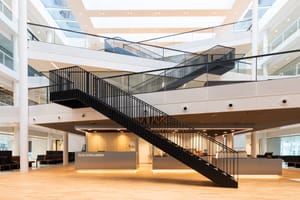In real estate, sustainability has evolved from a moral stance to a commercial imperative, critical for investors, lenders, planners, and occupiers, as stated by Artem Korolev, CEO of Mission Street. For occupiers, sustainable buildings not only help attract and retain talent but also enhance corporate reputation. For fund managers, sustainability features and performance are integral to their fiduciary responsibilities when making acquisitions.
A recent report by Harrison Street and Gensler points out that given the growing public consciousness and market demand for sustainable real estate, addressing decarbonisation diminishes the risk of having stranded assets and fortifies an asset's potential to maintain a competitive edge in the future market.
Most of the sustainability challenges faced by life sciences buildings are mirrored in the broader real estate sector; however, the scale of these challenges (such as energy consumption in labs) can be more pronounced.
The biggest environmental challenges facing real estate are:
- Carbon emissions: buildings account for a large proportion of global energy use and carbon emissions, making whole-of-life decarbonisation a priority.
- Climate change and resilience: the increasing frequency and severity of climate-related events such as floods, storms and wildfires pose significant risks to real estate assets. Adapting buildings and infrastructure to withstand these events is crucial for long-term sustainability.
- Waste management: construction and demolition activities generate a substantial amount of waste.
- Water use: efficient water management practices, such as water-saving fixtures, rainwater harvesting, and sustainable landscaping, are required to reduce pressure on local water resources.
- Urbanisation: rapid urbanisation can lead to the loss of natural habitats and green spaces, which affects biodiversity, air quality, and the ability to cope with higher temperatures.
These issues are also relevant to life sciences companies. The pharma and medtech sectors are notably energy-intensive, especially in manufacturing and maintaining controlled environments. The disposal of expired medications and single-use medical devices presents significant challenges, and laboratories consume substantial amounts of water.
From the wide range of sustainability challenges facing life sciences real estate, we will focus on three critical areas: energy consumption, water usage, and embodied carbon.
Energy consumption
Laboratories consume up to ten times more energy per square metre than standard commercial offices. The need for ventilation is one reason: depending on the size and specification, a fume hood can use anywhere between 200 and 1,000 cubic metres of air per hour. To put this in context, 1,000 cubic metres of air would fill about 10 single-decker buses.
Ultra-low-temperature (ULT) freezers are another energy guzzler: a single -80°C freezer can use as much power as a household. ULT freezers are also needed in the distribution chain.





